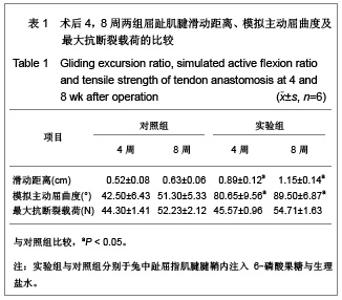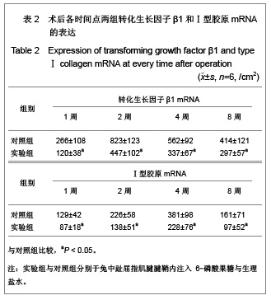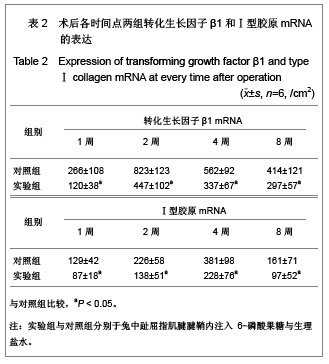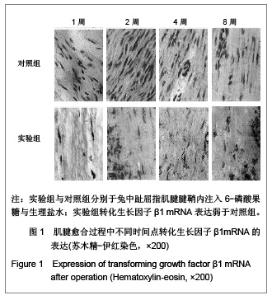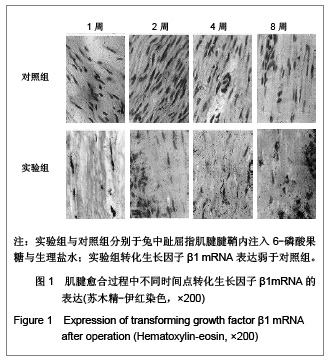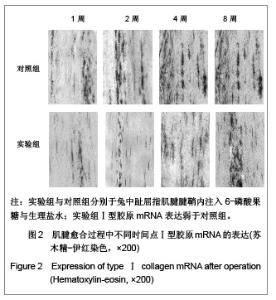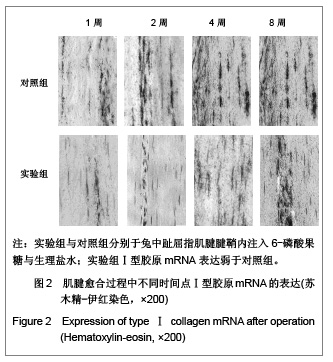| [1] Xia CS,Hong GX,Luo YZ,et al.Zhonghua Shouwaike Zazhi. 2005;21(1):56-59. 夏长所,洪光祥,罗元章,等.乳酸对肌腱腱鞘、腱外膜和腱内膜细胞增值和生物学活性的影响[J].中华手外科杂志,2005,21(1): 56-59.[2] Dennis PA, Rifkin DB. Cellular activation of latent transforming growth factor beta requires binding to the cation-independent mannose 6-phosphate/insulin-like growth factor type II receptor. Proc Natl Acad Sci USA. 1991;88(2): 580-584.[3] Wang ZH,Hong HY,Wang H,et al.Zhongguo Jiaoxing Waike Zazhi. 2011;16(21):1653-1655. 王振海,洪焕玉,王海,等.生物膜预防肌腱粘连的实验研究[J].中国矫形外科杂志,2011,16(21):1653-1655.[4] Cao Y,Tang JB. Resistance to motion of flexor tendons and digital edema: an in vivo study in a chicken model.J Hand SurgAm.2006;31(10):1645-1651.[5] Tsubone T,Moran SL,Subramaniam M,et al.Effect of TGF-beta inducible early gene deficiency on flexor tendon healing.J Orthop Res.2006;24(3):569-575.[6] Okamoto S,Tohyama H,Kondo E,et al.Ex vivo supplementation of TGF-beta1 enhances the fibrous tissue regeneration effect of synovium-derived fibroblast transplantation in a tendon defect: a biomechanical study. Knee Surg Sports Traumatol Arthrosc. 2008;16(3):333-339.[7] Xia CS,Hong GX,Yang XY,et al.Zhonghua Shiyan Waike Zazhi. 2006;23(9):1109-1111. 夏长所,洪光祥,杨选影,等.转化生长因子-β1对肌腱腱鞘、腱外膜和腱内膜细胞增殖和胶原产生的影响[J].中华实验外科杂志,2006,23(9):1109-1111.[8] Liu W,Cai Z,Wang D,et al.Blocking transforming growth factor-beta receptor signaling down-regulates transforming growth factor-beta1 autoproduction in keloid fibroblasts. Chin J Traumatol.2002;5(2):77-81.[9] Zang AY,Pham H,Ho F,et al.Inhibition of TGF-beta-induced collagen production in rabbit flexor tendons.J Hand Surg Am. 2004;29(2):230-235.[10] Chan KM,Fu SC,Wong YP,et al.Expression of transforming growth factor beta isoforms and their roles in tendon healing. Wound Repair Regen.2008; 16(3):399-407.[11] Kuo CK,Petersen BC,Tuan RS. Spatiotemporal protein distribution of TGF-betas, their receptors, and extracellular matrix molecules during embryonic tendon development. Dev Dyn.2008;237(5):1477-1489.[12] Fu SC,Cheuk YC,Chan KM,et al.Is cultured tendon fibroblast a good model to study tendon healing? J Orthop Res.2008; 26(3): 374-383.[13] Azuma C,Tohyama H,Nakamura H,et al.Antibody neutralization of TGF-beta enhances the deterioration of collagen fascicles in a tissue-cultured tendon matrix with ex vivo fibroblast infiltration.J Biomech. 2007;40(10):2184-2190.[14] Shimpuku E,Hamada K,Handa A,et al. Molecular effects of sodium hyaluronate on the healing of avian supracoracoid tendon tear: according to in situ hybridization and real-time polymerase chain reaction.J Orthop Res. 2007;25(2): 173-184.[15] Fang FJ,Cheng GL,Tao H,et al.Zhonghua Shouwaike Zazhi. 2005;21(1):49-52. 房锋俊,程国良,陶昊,等.鸡跖骨骨折4种内固定方法对肌腱损伤后粘连的影响[J]. 中华手外科杂志,2005,21(1):49-52. |
